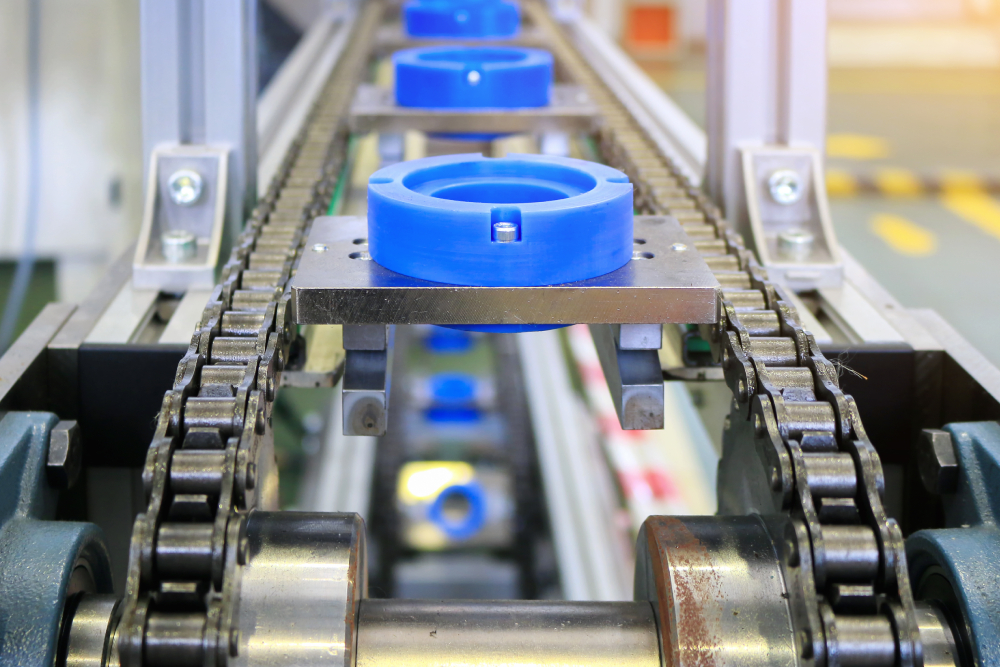

If you’ve spent any time around a factory floor, you know how much effort goes into moving heavy materials from one point to another. It’s not just about shifting weight it’s about doing it safely and keeping things running without interruption. When loads are massive and torque demands are high, a regular conveyor doesn’t cut it. That’s where chain conveyors quietly earn their keep.
They’re not new. They’re not flashy. But they work and that’s why they’re still everywhere, from foundries to assembly lines.
Built to Handle the Tough Stuff
The beauty of a chain conveyor is in its simplicity. Instead of relying on friction like a belt, the motor drives a linked chain that grips and pulls directly. There’s no slipping or stretching, just solid, mechanical movement. It’s the reason they can start under heavy load without hesitation.
In plants that deal with steel parts, large molds, or pallets stacked with product, that strength makes all the difference. When you flip the switch, you need the system to move no lag, no strain, just steady motion. Chain conveyors deliver exactly that.
Made for Harsh Environments
Factories are not kind to machinery. Heat, dust, and oil is a rough world. Chain conveyors are built to live in it. The chains are thick, the frames are over-engineered, and the sprockets keep turning long after lighter systems would have given up.
Ask any maintenance team why they like them, and you’ll probably hear the same thing: “They just don’t break down much.” A bit of grease here, an alignment checks there, and they’re good to go. Some of the oldest systems running today have been around for decades, quietly doing their job with minimal fuss.
Smooth, Predictable Motion
Despite being built for brute strength, chain conveyors are remarkably controlled. Because the drive links directly to the chain, there’s no slippage and the pace stays constant. That steady rhythm matters more than most people realize.
In automated setups, where robots, lifters, and assembly stations all depend on timing, that predictability keeps everything in sync. It reduces jams, prevents wear, and lets operators trust the system to do its part without constant adjustment.
Safety in Simplicity
Heavy machinery always comes with risk, but control reduces it. Chain conveyors move the same way every time with no sudden stops or jerks. Loads stay where they should. The movement is smooth enough that people working nearby can anticipate it.
Some modern setups add overload sensors or automatic shutoffs, which stop the conveyor before a jam damages the motor or the load. But even without high-tech add-ons, the steady nature of a chain conveyor makes the workspace safer by default.
Easy to Maintain, Built to Last
One of the reasons they’ve stuck around for so long is that they’re easy to look after. There are no complex maintenance schedules or hidden parts to replace. The main components of chains, sprockets, and bearings are right there in the open. If something wears down, you spot it, swap it, and carry it on.
When cared for properly, a good chain conveyor can outlive half the equipment around it. They’re the kind of machines you install once and forget until someone points out that it’s been running nonstop for ten years.
Final Thought
Chain conveyors aren’t trying to impress anyone. They’re workhorses steady, strong, and reliable. In industries where torque is high, loads are heavy, and downtime costs money, that’s exactly what you need.
They don’t make headlines. They just keep the line moving. And sometimes, that’s the most important thing a machine can do.
Automag India is a prominent chain conveyor manufacturer in India that keeps raising the bar for industrial automation and precise engineering. To increase the productivity of your production line, contact us right now if you’re searching for a reliable chain conveyor provider.
Visit: https://automagindia.com/contact-us
READ MORE
How to Choose the Right Chain Conveyor Supplier for Your Industry Needs
What is a Top Chain Conveyor and How Does It Work?
Chain Conveyors or Roller Conveyors? Make the Right Choice for Your Faculty


